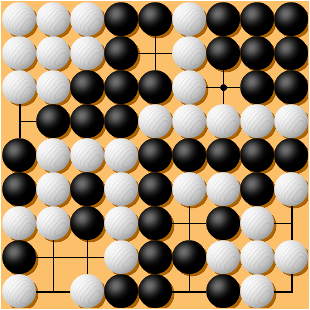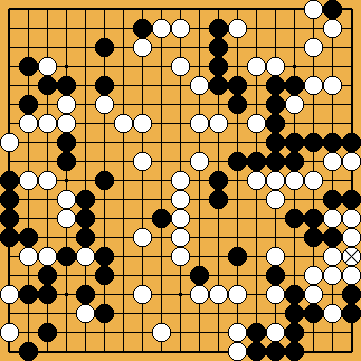Harry Fearnley
The broad areas of interest to me are outlined below.
Go
I am particularly interested in any/all
material related to the
oriental board game Go
– Japanese: 囲碁 (Igo),
Chinese: 围棋/圍棋(WéiQí [Wei-Ch'i]), Korean: 바둑 (Baduk/Paduk).
The Go topics that I specialize in are:
-
An overview of shared life (seki) in Go, which links to my other work on seki
(Korean: bik, Chinese: shuang huo) ...
-
Seki: Hanezeki -- shared life and (generalized) Hanezeki (Korean: jeochim bik), which I now prefer to call "Tail Seki"
-
Seki: Nakade -- shared life and (generalized) nakade (Korean: chijung, Chinese: dianyan)
-
Gurvich and Gol'berg's 1980 paper on (fully-connected) seki
- Shimada's work --
Igo no Suri -- some formal/mathematical reflections -- 1958 edition
-
Bestiary -- brain hurts!
-
Bestiary: Molasses Ko, etc
-
Bestiary: Rule challenging
-
Multistage Kos -- Zippers, etc -- some very improbable Ko (Korean: pae, Chinese: jie)
-
A little problem with many big kos, and its
interactive version
- The Most Difficult Problem Ever – a beautiful
problem from the Hatsuyoron (1713), requiring the use of
hanezeki/ tail-seki –
see Thomas Redecker's work on
Igo Hatsuyoron, Problem 120,
for which I have provided an
interactive version (out-of-date)!
In 2011, while working on this problem, I discovered/ invented a new form of Seki --
a Circular Tail Seki (AKA Circular Hanezeki). "Inside" the Seki, there are two groups, each of which can capture the same number (3) of "internal" (Nakade) stones.
However, there are two unusual features relating to the "Tail":
- The Seki includes a pair of groups -- the "Tail", and the adjacent one-eyed group --
which share 5 liberties, on which neither wants to play, despite the fact that ...
- One of these two groups has an eye, and the other has none!
There is a description of how that Circular Tail Seki works.
It is the "simplest/ smallest" Circular Tail Seki (Hanezeki).
Since then (in 2017?) -- along similar lines -- I created the "largest" Circular Tail Seki.
Here, the "Tail", and the adjacent group, share 14 liberties (the maximum possible in a Circular Tail Seki)
on which neither player wants to play!
In this case, "inside" the Seki, each of the players can capture a 6-stone Nakade shape (potentially worth 12 liberties).
Sensei's Library has links to
other material on the Igo Hatsuyoron 120 problem.
The AI KataGo has made several interesting discoveries in 2020 -- described in lifein19x19
- Go in Britain
- Computers and Go
- TsumeGo -- Life and death problems
- Rulesets; Combinatorial Games Theory; Mathematics and Go
- Playing Go on the Internet
- Books about Go -- various languages
-
A book review of Daniele Pecorini and Tong Shu's book The Game of Wei-Chi.
Mathematics
I also have various recreational interests in Mathematics -- particularly in:
- Wavelets, Fourier Transforms etc -- especially discrete versions, such as the
Hadamard/ Walsh Transform
- Tessellations, or Tilings.
- Conway's game "Life", as well as other Cellular Automata, and Artificial Life stuff.
I am particularly interested in Elementary Cellular Automata, especially since
Matthew Cook has demonstrated
that at least one of these is capable of universal computation.
Other
Other interests include:
Contact info:
Updated 2021/05/04
Page maintained by
harryfearnley@gmail.com



